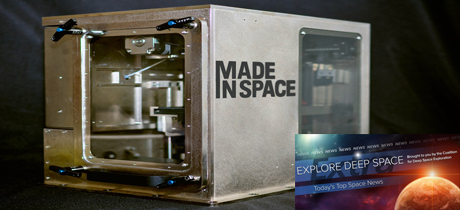The Coalition for Deep Space Exploration wishes you all a Happy Thanksgiving. Extra will return on Monday, November 27, 2017.
In Today’s Deep Space Extra… Made In Space preps space metal 3-D printing capabilities. Astronomers welcome an asteroid from another solar system.
Human Space Flight
Metal 3-D Printing Capabilities Readied For ISS
Coalition Member in the News (Made In Space)
Subscription Required
Aviation Week (11/16): Silicon Valley based Made In Space, Inc., is developing the additive manufacturing technologies to add metal component production to its 3-D polymer printing capabilities aboard the International Space Station. The goal is printing, milling and casting technologies for precision parts made of aluminum, stainless steel and titanium. The advances would find a place within NASA’s human deep space exploration plans.
International cooperation and competition in space (part 1)
The Space Review (11/20): Space, as it was when visited by the first terrestrial spacecraft, remains a realm for competition, cooperation and strategic balancing. It’s a formula likely to endure. However, it’s not so much a race at this juncture as it is a road to profitable firsts and longer term efforts to establish capabilities, writes Cody Knipfer, a grad student in space policy at George Washington University, in the first of a two part assessment.
Space Science
Wow! 1st interstellar asteroid is a spinning space cigar
Space.com (11/20): October 19 offered astronomers using the powerful Pan STARRS 1 observatory in Hawaii the surprise detection of an interstellar asteroid. “This history-making discovery is opening a new window to study formation of solar systems beyond our own,” said Thomas Zurbuchen, NASA’s associate administrator for space science.
Weird dark streaks on Mars may not be flowing water after all
Space.com (11/20): For a while now, astronomers have speculated that seasonal streaks appearing on sloped regions of the Martian terrain were caused by flowing water, either seasonally drawn from below the surface or the thin atmosphere. A new interpretation suggests, however, the streaks can be attributed to flowing sand alone. The observations are attributed to NASA’s Mars Reconnaissance Orbiter.
NASA confirms contribution to Japanese-led Mars mission
Spaceflightnow.com (11/20): NASA will contribute a science instrument to the Japan Aerospace Exploration Agency led Martian Moon exploration mission set to launch in 2024. The Applied Physics Laboratory’s neutron and gamma ray spectrograph will help JAXA decide where to land on the moon Phobos to gather samples for return to Earth.
Other News
America’s oldest rocket just made its penultimate flight
Coalition Member in the News (United Launch Alliance)
Ars Technica (11/20): With a development history that reaches back to post World War II intercontinental ballistic missile development, the United Launch Alliance’s Delta II rocket is nearing the end of the road. The launch vehicle successfully boosted a NOAA/NASA advanced weather satellite, JPSS-1, into polar orbit from Vandenberg Air Force Base, California early Saturday, its 154th mission, and 99th success in a row. It’s final mission, the launch of NASA’s ICE-Sat 2, is planned for September.
A landing lifts Dream Chaser’s prospects
The Space Review (11/20): Sierra Nevada Corp’s commitment to the commercial prospects of space paid a hard earned dividend earlier this month as its winged, reusable Dream Chaser succeeded in a glide test at Edwards Air Force Base, California. A future NASA contracted resupply services provider for the International Space Station, Sierra Nevada intends to launch Dream Chaser on a United Launch Alliance Atlas V and return to a runway. Its contract to deliver and return cargo from the Space Station spans 2019 to 2024.
Space firms focus on potential workforce shortage
Orlando Sentinel (11/20): Florida’s Space Coast could face a shortage of skilled workers as new companies like Blue Origin and SpaceX arrive and grow alongside traditional companies. Sixty two percent of the current engineers in Brevard County, for example, are 45 years or older. Building a workforce pipeline is essential. “Our goal is to inspire that STEM workforce because without it, we all fall,” said Steven Botwinik, Lockheed Martin’s director of advanced programs for its Orlando-based Missiles and Fire Control division. “If it is not there for all of us, none of us will succeed.”

